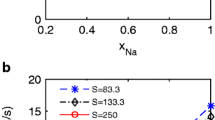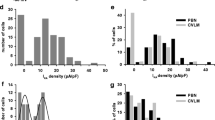Abstract
We have studied the selective effects of noxiustoxin (NTX), a fraction of the venom of the scorpionCentruroides noxius, on the K currents of perfused squid giant axons using the voltage-clamp technique. At concentrations below 1.5 μM, NTX blocked K currents in a voltage-independent manner, with little effect on their turning-on and turning-off kinetics. Above 1.5 μM, the block by NTX became voltagedependent and could be partially removed by repetitive pulsing and strong depolarizations. Long repolarizations and more negative holding potentials favoured the slow restoration of channel block. Reduction of K currents by internally perfusing the fibers with solutions of low K+ concentration (200 mM), affected very little the removal of NTX-block during repetitive pulsing, suggesting that block removal depended on membrane potential and not on outward movements of K+ ions through open channels. In high extracellular K+ (300 mM) the blocking action of NTX was reduced and the instantaneous I–V characteristics showed a marked outward rectification. At 20 μM NTX, inward tail currents measured on step repolarizations to −70 mV were fully blocked, suggesting a direct interaction of the toxin with the open channel. The effects of the total venomCentruroides noxius Hoffmann was also studied. External application of 0.25 mg/ml of the venom caused a marked reduction of both Na and K currents, an effect similar to that of other scorpion venoms.
Similar content being viewed by others
References
Adams G (1973) The effect of potassium diffusion through the Schwann cell layer on potassium conductance of the squid axon. J Membr Biol 13:353–386
Adelman WJ Jr, Palti Y, Senft JP (1973) Potassium ion accumulation in a periaxonal space and its effect on the measurement of membrane potassium ion conductance. J Membr Biol 13:387–410
Armstrong CM, Taylor SR (1980) Interaction of barium ions with potassium channels in squid giant axons. Biophys J 30:473–488
Armstrong CM, Swenson RP Jr, Taylor SR (1982) Block of squid axon K channels by internally and externally applied barium ions. J Gen Physiol 80:663–682
Barhanin J, Pauron D, Lombet A, Norman RJ, Vijverberg HPM, Giglio JR, Lazdunski M (1983) Electrophysiological characterization, solubilization and purification of theTityus γ toxin receptor associated with the gating component of the Na+ channel from rat brain. EMBO J 6:915–920
Bernard P, Couraud F, Lissitzky S (1977) Effects of scorpion toxin fromAndroctonus australis venom on action potential of neuroblastoma cells in culture. Biochem Biophys Res Commun 77:782–788
Cahalan MD (1975) Modification of sodium channel gating in frog myelinated nerve fibers byCentruroides sculpturatus scorpion venom. J Physiol 244:511–534
Carbone E, Fioravanti R, Prestipino G, Wanke E (1978) Action of extracellular pH on Na+ and K+ membrane currents in the giant axon ofLoligo vulgaris. J Membr Biol 43:295–315
Carbone F, Testa PL, Wanke E (1981) Intracellular pH and ionic channels in theLoligo vulgaris giant axon. Biophys J 35:393–413
Carbone E, Wanke E, Prestipino G, Possani LD, Maelicke A (1982) Selective blockage of voltage dependent K+ channels by a novel scorpion toxin. Nature 295:90–91
Carbone E (1982) Removal of Na+ channels in squid giant axons by perfusion with trypsin. Biochim Biophys Acta 693:188–194
Carbone E, Prestipino G, Wanke E, Possani LD, Maelicke A (1983) Selective action of scorpion neurotoxins on the ionic currents of the squid giant axon. Toxicon (Suppl) 3:57–60
Carbone E, Prestipino G, Franciolini F, Dent MAR, Possani LD (1984) Selective modification of the squid axon Na currents byCentruroides noxius toxin II-10. J Physiol (Paris) 79:179–184
Catterall WS (1979) Binding of scorpion toxin to receptor sites associated with sodium channels in frog muscle. J Gen Physiol 74:375–391
Conti F, Hille B, Neumcke B, Nonner W, Stämpfli R (1976) Conductance of the sodium channel in myelinated nerve fibers with modified sodium inactivation. J Physiol 262:729–742
Cole KS, Moore JW (1960) Potassium ion current in the squid giant axon: dynamic characteristic. Biophys J 1:1–16
Couraud F, Jover E, Dubois JM, Rochat H (1982) Two types of scorpion toxin receptor sites, one related to activation, the other to inactivation of the action potential sodium channel. Toxicon 20:9–16
Dodge FA, Frankenhaeuser B (1959) Sodium currents in the myelinated nerve fibre ofXenopus laevis investigated with the voltage clamp technique. J. Physiol. 148:188–200
Dolly JO, Halliwell JV, Black JD, Williams RS, Pelchen-Matthews A, Breeze AL, Mehraban F, Othman IB, Black AR (1984) Botulinum neurotoxin and dendrotoxin as probes for studies on transmitter release. J Physiol (Paris) 79:280–303
Frankenhaeuser B, Hodgkin AL (1956) The after-effects of impulses in the giant nerve fibres ofLoligo. J Physiol 131:341–376
Gillespie JI, Meves H (1980) The effect of scorpion venoms on the sodium currents of the squid giant axon. J Physiol 308:479–499
Hanke W, Boheim G, Barhanin J, Pauron D, Lazdunski M (1984) Reconstitution of highly purified saxitoxin sensitive Na+-channels into planar lipid bilayers. EMBO J 3:509–515
Hu SL, Meves H, Rubly N, Watt DD (1983) A quantitative study of the action ofCentruroides sculpturatus toxins III and IV on the Na currents of the node of Ranvier. Pflügers Arch 397:90–99
Jonas P, Vogel W, Arantes EC, Giglio JR (1986) Toxin γ of the scorpionTityus serrulatus modifies both activation and inactivation of sodium permeability of nerve membrane. Pflügers Arch 407:92–99
Koppenhofer E, Schmidt H (1968) Die Wirkung von Skorpiongift auf die Ionenströme des Ranvierschen Schnürrings. I. Die Permeabilitäten PNa and PK. Pflügers Arch 303:133–149
Meves H, Pichon Y (1977) The effect of internal and external 4-aminopyridine on the potassium currents in intracellularly perfused squid giant axons. J Physiol 268:511–532
Meves H, Rubly N, Watt DD (1982) Effect of toxins isolated from the venom of the scorpionCentruroides sculpturatus on the Na currents of the node of Ranvier. Pflügers Arch 393:59–62
Meves H, Rubly N, Watt DD (1984a) Voltage-dependent effect of a scorpion toxin on sodium current inactivation. Pflügers Arch 402:24–33
Meves H, Simard JM, Watt DD (1984b) Biochemical and electrophysiological characteristics of toxins isolated from the venom of the scorpionCentruroides sculpturatus. J Physiol (Paris) 79:185–191
Miller C, Moczydlowski E, Latorre R, Phillips M (1985) Charybdotoxin, a protein inhibitor of single Ca2+-activated K+ channels from mammalian skeletal muscle. Nature 313: 316–318
Mozhayeva GN, Naumov AP, Nosyreva ED, Grishin EV (1980) Potential-dependent interaction of toxin from venom of the scorpionButhus eupeus with sodium channels in myelinated fibre. Voltage clamp experiments. Biochim Biophys Acta 597:587–602
Narahashi T, Shapiro JB, Deuguchi T, Scuka M, Wang CM (1972) Effects of scorpion venom on squid axon membranes. Am J Physiol 222:850–857
Nonner W (1979) Effects ofLeirus scorpion venom on the gating current in myelinated nerve. In: Ceccarelli B, Clementi F (eds) Advances in cytopharmacology. Vol 3. Raven Press, New York
Pichon Y, Pelhate M (1984) Effect of toxin 1 fromAndroctonus Australis Hector on sodium currents ofLoligo forbesi. J Physiol (Paris)79:318–326
Possani LD, Dent MAR, Martin BM, Maelicke A, Svendsen I (1981) The aminoterminal sequence of several toxins from the venom of the Mexican scorpionCentruroides noxius Hoffmann. Carlsberg Res Commun 46:207–214
Possani LD, Martin BM, Svendsen IB (1982) The primary structure of Noxiustoxin: a K+ channel blocking peptide, purified from the venom of the scorpionCentruroides noxius Hoffmann. Carlsberg Res Commun 47:285–289
Romey G, Chicheportiche R, Lazdunski M, Rochat H, Miranda F, Lissitzky S (1975) Scorpion neurotoxins. A presynaptic toxin which affects both Na+ and K+ channels in axons. Biochem Biophys Res Commun 64:115–121
Vijverberg HPM, Pauron D, Lazdunsky M (1984) The effect ofTityus serrulatus scorpion toxin γ on Na channels in neuroblastoma cells. Pflügers Arch 401:297–303
Wang GK, Strichartz GR (1983) Purification and physiological characterization of neurotoxins from venoms of the scorpionsCentruroides sculpturatus andLeiurus quinquestriatus. Mol Pharmacol 23:519–533
Wanke E, Carbone E, Testa PL (1979) K+ conductance modified by a titratable group accessible to protons from the intracellular side of the squid axon membrane. Biophys J 26:319–324
Wanke E, Testa PL, Prestipino G, Carbone E (1983) High intracellular pH reversibly prevents gating-charge immobilization in squid axons. Biophys J 44:281–284
Weller U, Bernhardt U, Siemen D, Dreyer F, Vogel W, Habermann E (1985) Electrophysiological and neurobiochemical evidence for the blockade of a potassium channel by dendrotoxin. Naunyn-Schmiedeberg's Arch Pharmacol 330:77–83
Wheeler KP, Watt DD, Lazdunsky M (1983) Classification of Na channel receptors specific for various scorpion toxins. Pflügers Arch 397:164–165
Yeh JZ, Oxford GS, Wu CH, Narahashi T (1976) Dynamics of aminopyridine block of potassium channels in squid axon membrane. J Gen Physiol 68:519–535
Zaborovskaya LD, Khodorov BI (1985) Effect ofTityus γ toxin on the activation process in sodium channels of frog myelinated nerve. Gen Physiol Biophys 4:101–104
Author information
Authors and Affiliations
Rights and permissions
About this article
Cite this article
Carbone, E., Prestipino, G., Spadavecchia, L. et al. Blocking of the squid axon K+ channel by noxiustoxin: a toxin from the venom of the scorpionCentruroides noxius . Pflugers Arch. 408, 423–431 (1987). https://doi.org/10.1007/BF00585064
Received:
Accepted:
Issue Date:
DOI: https://doi.org/10.1007/BF00585064




